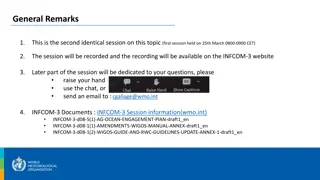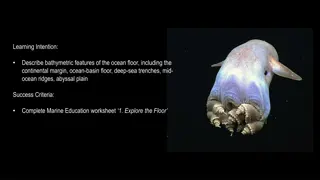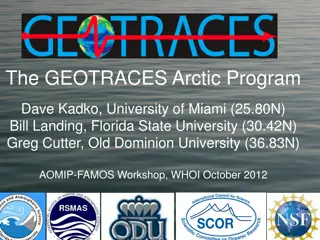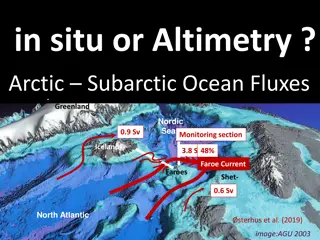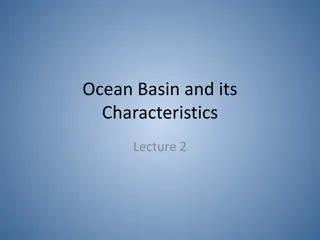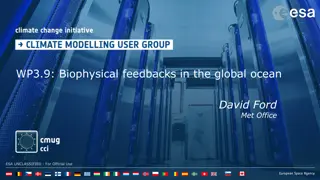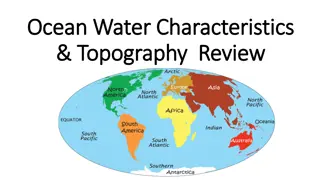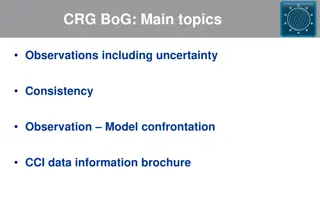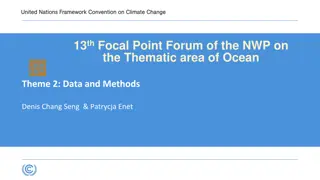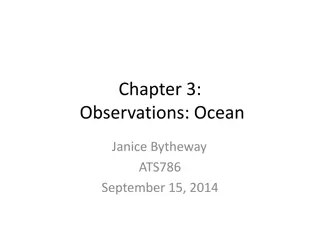Advancing Climate Research: Topics and Challenges in Ocean Observations and Modeling
Exploring topics like ocean heat transport, coastal upwelling, biogeochemical model requirements, and air-sea interactions within the US-CLIVAR panels. Additionally, understanding the importance of global observation capabilities in constraining climate sensitivity and enhancing modeling efficiency across various scales presents a significant opportunity in climate research.
Download Presentation

Please find below an Image/Link to download the presentation.
The content on the website is provided AS IS for your information and personal use only. It may not be sold, licensed, or shared on other websites without obtaining consent from the author.If you encounter any issues during the download, it is possible that the publisher has removed the file from their server.
You are allowed to download the files provided on this website for personal or commercial use, subject to the condition that they are used lawfully. All files are the property of their respective owners.
The content on the website is provided AS IS for your information and personal use only. It may not be sold, licensed, or shared on other websites without obtaining consent from the author.
E N D
Presentation Transcript
Possible Relevant Scientific Topics within US-CLIVAR Phenomena and Observing System (POS) Panel - Ocean heat transport in eastern tropical basins (tracers would help resolve) - Coastal upwelling (importance of local forcing and processes of water transport) - More sophisticated biogeochemical model requirements for verification Process Studies and Model Improvement Panel (PSMIP) - Air-sea interactions - Mesoscale ocean mixing - Southern Ocean and dynamics of atmosphere, ocean mixing and carbon uptake Predictability, Prediction and Applications Interface (PPAI) Panel - Global general circulation and carbon uptake - Air-sea exchange and ocean mixing - Using biological system indicators
Global Observation Capabilities (Scott Doney) Observations can constrain climate sensitivity to carbon forcing and carbon cycle sensitivity to changes in climate Observing systems: - Repeat Hydrography (example of effective international collab) - Tracers - VOS measurements - Moored arrays - Profiling floats w/ Oxygen, Nitrate, bio-optics - Gliders - Satellite remote sensing of ocean color, SST, SSH, winds Needs: - Methods and best practices to address incomplete coverage and distribution of biogeochemical and physical measurements systematic approach to profiling float deployment (suggestion to base on analyses of physical drivers) address holes in pCO2 measurements by VOS tracks and N-S repeat lines (require higher frequency than every 10 yrs) deep ocean measurements of physical and biogeochemical variables (6000m depth profiling floats being developed) land/ocean boundary measurements to examine physics and address significant modeling errors/uncertainties - Collaboration between GEOTRACES and CLIVAR - Synthesized data sets with error estimates (funding required) - Studies of systematic biases of atmospheric CO2 fluxes; lack data to examine importance of boundary layer stability - Review of how errors in atmospheric reanalyses propagate into biogeochemistry analyses
Global Modeling Challenges & Opportunities (Mick Follows) Do we understand the Earth system well enough to develop models that can effectively simulate climate over seasonal to interglacial timescales? Major modeling challenge to bridge significantly disparate scales - physical scales from molecular diffusion to global overturning - biogeochemical scales from intra-cellular metabolic networks to global biogeography Understanding small scale processes necessary to develop parameterizations for climate modeling Characterizing and quantifying traits and trade-offs at the scale of individuals is a critical step in advancing trait-based representations of marine ecosystems and biogeochemical cycles Microbes are implicated for efficiency of recycling, export and storage of carbon; fitness and population of microbial communities determined by both physical and biological inputs Genomic and molecular approaches provide information at the cellular scale, but parameterization is necessary for global climate scale studies Discussion Considerations of biological modeling Gene information will help establish geography of carbon sources Instead of focusing on individual species, recommendation to focus on collection of functional groups to build biogeochemical models A key link between physical and biogeochemical modeling is in the resolution of space and time scales - Importance of mixing parameterizations for upwelling of nutrients - Land-ocean boundaries in physical ocean modeling represent a difficult challenge; ultra-high resolution and nested approaches being applied
Overturning Circulation Impacts (Alison Macdonald) Review of global zonal integrated estimates of overturning (cross-isopycnal flow) in Atlantic and Pacific basins Heat transport depends on both vertical and horizontal temperature differences Impacts of overturning on Carbon including interaction of timescales Discussion - Centennial scale problem has link to biological scales which feed back to centennial scales - Link between overturning and biology in space/time - Weak link on OCB side is observing system; don t have resolution beyond satellite in the SO.
Carbon as Velcro Connecting Physical Climate Variability and Biogeochemical Dynamics in the Southern Ocean (Nikki Lovenduski) Mean State -Establishing the size of the SO CO2 sink -Explaining the strong spread of IPCC modeled cumulative anthropogenic CO2 uptake in SO (physics and ecology) -Role of eddies in CO2 uptake and transport Variability Determining how eddies respond to increasing wind stress Observational needs for physical circulation, CO2 fluxes and storage, and ecology Future Changes Impacts of stratification of SO on carbon storage and ecology Wind driven circulation changes and impacts on carbon and ecology Pace of SO acidification Discussion -Data needed to constrain models - Impact of atmospheric model choice to force the ocean model and frequency of forcing - Impact of using coupled ocean-sea ice model; sea ice expected to respond to ocean interactions; increase in ice will impact biology - Lack of understanding if ACC follows the wind or is locked to topography
Coupled Air-Sea Interaction and Variability in Ocean Biogeochemistry (Curtis Deutsch) Case studies in carbon and oxygen cycles of the tropical Pacific which, based on empirical relationships, accounts for the largest fraction of global ocean CO2 variability Review of El Nino and CO2 flux drivers, impact of shifting ENSO frequency, future climate (weakening Walker cell) and CO2 outgasing and uptake Mechanisms of O2 variability (thermocline depth variations), future climate and ocean hypoxia/anoxia Climate warming is predicted to cause a slowdown of CO2uptake and a deoxygenation of the ocean Discussion - Can use profiling floats to directly measure seasonal cycle of O2 - For which processes, and at which time scales, is natural variability in carbon cycle a useful analogue of long-term trends? (Where are amplitudes likely correlated across time scales?) - What are the observational requirements to narrow the intermodel range at the shorter time scales (e.g. seasonal cycle to interannual variability)? - Do we need a coordinated effort to analyze the upcoming IPCC archive in these ways?
Sub-daily to Seasonal and Sub-Mesoscale to Mesoscale Processes and Interaction with Ocean Biology (Amala Mahadevan) Observation and model based examination of relative roles of physical and biological processes underlying spatial variability of phytoplankton and occurrence of blooms in: - Subtropical gyres physical processes dominate with lateral mesoscale eddy mixing and sub- mesoscale nutrient upwelling - Subpolar gyres biological processes dominate with eddy-induced restratification and shoaling of mixed layer and higher average light - Coastal margins both contribute with strong upwelling of nutrients and rapid lateral advection in sub-mesoscale filaments Importance of representing sub-mesoscale processes in coupled climate-biogeochemical models to understand basin-scale productivity Discussion - Concern on increasing resolution by order of magnitude-could impact hydrostatic balance - Sub-mesoscale impacts of biological processes on temperature not examined on shorter timescales - Limitations of high resolution modeling for mixing; limitations of observations for high vertical velocity events
US CLIVAR Benefits from OCB Collaboration Ocean Observations - Quantify size of sink, constrain carbon cycle in ocean models - Importance of biogeochemical tracers for constraining modeled ocean circulation; are they better (more easily measured, more discrete) than physical measurements? Model development and analysis - Need for and limits of increased model resolution - Processes and observational constraints Coupled Model Prediction - Impact of time-varying carbon and biogeochemical cycling on climate prediction; how do uncertainties in biogeochemical modeling impact climate prediction? - Impact of DMS aerosols on variability and change - Impact of biomass on ocean temperature Sarmiento presenting at 4:45pm in PSMI Panel on Proposal for a Southern Ocean Biogeochemical Observations and Modeling (SOBOM) Program Would be good for POS Panel members to attend.




